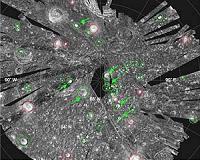 |
Cologne, Germany (SPX) Mar 29, 2010 It takes some imagination - the new exhibit on display at the 'Out of this World - Wonders of the Solar System' exhibition at the Gasometer Oberhausen, does not look very spectacular at first glance. Lent to the German Aerospace Center (Deutsches Zentrum fur Luft- und Raumfahrt; DLR) by NASA, it is grey in colour, small - weighing just 92.5 grams - and encased in a Plexiglas casting. But this small piece of rock is no lightweight in its significance and value. It originates from another celestial body and is therefore priceless. "There is no open market for rock samples from the Apollo missions. It would therefore be impossible to establish any financial value," states Gary Lofgren, Administrator of the NASA Lunar Sample Laboratory in Houston, Texas. This is the storage location for all the samples collected during the Apollo missions. None of these lunar surface samples is available for sale. Collectors are only permitted to sell meteorite fragments found on Earth. "Meteorites from the Moon are traded at around 2000 USD per gram." But at the end of the day, that does not become a benchmark market price for lunar samples. The NASA storage facility in Houston is home to 382 kilograms of rocks, dust and drill cores from the Moon.
By 'moon buggy' all the way to Hadley Rille At that time, no astronaut had ever ventured as far from a landing module. Scott then collected volcanic rock from the rim of the Mare Imbrium impact crater. This lump of rock weighed 9.5 kilograms and was duly logged into the Lunar Sample Laboratory and archived as number 15555. It also became known as 'Great Scott'. This name was a carefully chosen one: firstly, Great Scott is the largest piece of rock that returned to Earth on board Apollo 15. Secondly, it honours the work of Commander Dave Scott during his two-day stay on the Moon. To facilitate access for scientists and museums, NASA prepared various items from this large sample, one of which was this particular exhibit. 'Great Scott' is very similar to basaltic rock found here on Earth. However, things start to get really interesting when scientists get to grips with the age of this sample. Volcanic rock on Earth seldom comes close to being three billion years old. In contrast, 'Great Scott' and the small sample bearing number 15333.462 originated on the Moon 3.3 billion years ago. The oldest samples are more than four billion years old. "With lunar rock, we are effectively looking through a window at the very distant past of Earth, when our planet was still young", says Ulrich Kohler from the DLR Institute of Planetary Research (Institut fur Planetenforschung; IPF). Back in the early days of Earth and the Moon, their surfaces were covered in oceans of molten magma over which a rocky crust eventually formed. Before this, the Moon was formed from the debris of Earth's collision with a body the size of Mars.
Researching lunar rock "For the very first time, we were in the possession of extra-terrestrial material whose origins were known to us with absolute precision, thus contrasting sharply to meteorites found on Earth." First, scientists tested the chemical composition and the age of these samples. Even today, lunar rocks are being researched and analysed by scientists around the globe. "We are still addressing the same questions that we had 40 years ago - it's just that now we have newer and better methods at our disposal. And that's why we keep coming up with more new results," says Kohler.
Scientific treasure of enormous significance Workers on location in Houston handle these extra-terrestrial rocks and drill cores only with triple-thickness gloves and specially cleaned tools. "These samples are a scientific treasure of enormous significance", added Kohler. Indeed, the lunar samples are guarded just like real treasure at their 'home' in Houston. "We have taken extensive security precautions," says Curator Gary Lofgren. No further details are forthcoming. The Lunar Sample Laboratory has even been specially prepared to withstand natural catastrophes. In case a tornado or a hurricane strikes the site, the lunar samples are stored at a height that is safe even in the event of flooding. How then, can museums protect these exhibits? "We stipulate the security criteria with which they must comply." The lunar rock will be on show at the Gasometer Oberhausen in the 'Out of this World - Wonders of the Solar System' exhibition until 13 April 2010. This exhibition is also, incidentally, home to the 'largest Moon on Earth'.
Share This Article With Planet Earth
Related Links DLR Mars News and Information at MarsDaily.com Lunar Dreams and more
 The Mystery Of Moonwater
The Mystery Of MoonwaterHuntsville AL (SPX) Mar 19, 2010 Moonwater. Look it up. You won't find it. It's not in the dictionary. That's because we thought, until recently, that the Moon was just about the driest place in the solar system. Then reports of moonwater started "pouring" in - starting with estimates of scant amounts on the lunar surface, then gallons in a single crater, and now 600 million metric tons distributed among 40 craters near the lun ... read more |
|
| The content herein, unless otherwise known to be public domain, are Copyright 1995-2010 - SpaceDaily. AFP and UPI Wire Stories are copyright Agence France-Presse and United Press International. ESA Portal Reports are copyright European Space Agency. All NASA sourced material is public domain. Additional copyrights may apply in whole or part to other bona fide parties. Advertising does not imply endorsement,agreement or approval of any opinions, statements or information provided by SpaceDaily on any Web page published or hosted by SpaceDaily. Privacy Statement |